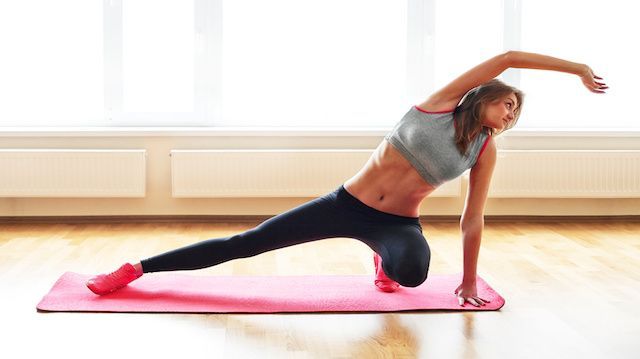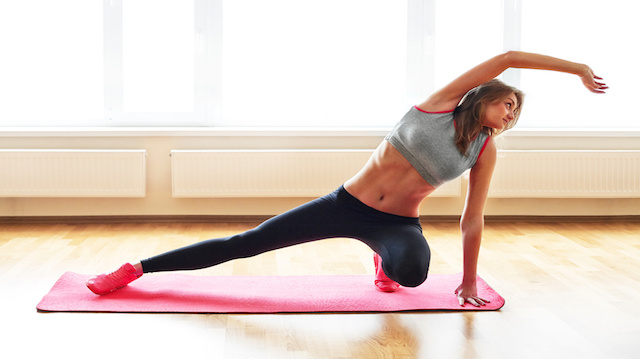
Many people think of yoga as an active, dynamic, and movement centered practice, but did you know yoga also has a tranquil, gentle side? In a restorative yoga practice, relaxing yoga poses are held for around 5–10 minutes each. Unlike many other yoga styles, these poses are completely passive and require no effort on your part once you’re in them. The only goal is to totally relax and feel completely and utterly comfortable.
Restorative yoga is a great practice for people who often feel anxious, stressed, or under pressure (most of us!), as well as people who feel “burnt out” or are experiencing adrenal fatigue. It’s also a great practice to do right before going to sleep, and all of these poses can actually be done from the comfort of your bed!
Usually restorative yoga poses are made as relaxing and nurturing as possible with props like yoga bolsters, blankets, straps, sand bags, and even scented eye pillows. But you can do all of the poses included in this article with just a couple of pillows and blankets.
As you do each of these postures, here are a few things to remember:
- Comfort is key. Unlike other yoga styles, you shouldn’t feel any kind of tension in your body, and should only feel a gentle stretch at most. The goal instead is to feel completely at ease, like you’re floating on a cloud or down a gentle river or stream.
- Focus on your breath. Once you’re comfortable in the shape of the posture, begin to focus your attention on your breath, either on the sensation of your breath as it enters and exits your nostrils, or on the way you torso rises and falls with your inhalations and exhalations. Breathing during these poses should be long and deep, but relaxed. Don’t try to force the breath, as this is a form of tension.
- Unexpected emotions may emerge. Deep states of relaxation coupled with stillness can trigger buried emotions — both positive and negative — to rise to the surface. If this happens, just think of it as an emotional detox. Observe the emotions, and then let them go.
Ready to relax and renew? Here are the poses you need to know:
Child’s Pose (Balasana)
Child’s pose is practiced in most styles of yoga. The difference with the restorative version is that instead of placing your torso directly on the mat or ground, you allow your chest and head to be supported by a bolster or pillows.
How to do this pose:
Starting on your knees, bring your knees so they’re slightly wider than your hips, and the tops of your feet together so they’re touching behind you. Stack two pillows (the kind you sleep on) in front of you, a few inches away from your knees. Bring your torso down onto the pillows, so that your body is resting on the pillows from your pelvis to your head. Allow your arms to rest alongside the pillows, and turn your head in either direction. Adjust as needed until you’re completely comfortable, and then stay in the posture, breathing deeply, for around 4–5 minutes. After about two minutes, remember to turn your head to the opposite side.
Legs Up the Wall (Viparita Karani)
This pose is wonderful for relieving stress, supporting healthy blood circulation, and balancing hormones.
How to do this pose:
 Find a cozy place in your home where the floor (or your bed) meets the wall. When you find the perfect spot, fold two blankets, and place one about 12 inches from the wall and the other about three feet from the wall. Then, sit against the wall with your knees bent up toward your chest, and the right side of your body touching or almost touching the wall. Using your arms to support you, try to swing your legs up so that you’re lying on the floor, and the backs of your legs are resting against or almost against the wall. The first blanket should be under the curve in your lower back, and the second should be supporting the arch of your neck. Your arms can fall alongside you or you can fold them in so your hands are resting on your belly. Adjust if necessary so your legs, hips, back, neck, and head are all comfortable — this may require moving your hips a bit further away from the wall or making some blanket adjustments. Once you’re comfortable, close your eyes and breathe deeply through the nose for five minutes or more.
Find a cozy place in your home where the floor (or your bed) meets the wall. When you find the perfect spot, fold two blankets, and place one about 12 inches from the wall and the other about three feet from the wall. Then, sit against the wall with your knees bent up toward your chest, and the right side of your body touching or almost touching the wall. Using your arms to support you, try to swing your legs up so that you’re lying on the floor, and the backs of your legs are resting against or almost against the wall. The first blanket should be under the curve in your lower back, and the second should be supporting the arch of your neck. Your arms can fall alongside you or you can fold them in so your hands are resting on your belly. Adjust if necessary so your legs, hips, back, neck, and head are all comfortable — this may require moving your hips a bit further away from the wall or making some blanket adjustments. Once you’re comfortable, close your eyes and breathe deeply through the nose for five minutes or more.
Reclining Bound Angle Pose (Supta Baddha Konasana)
This posture provides a gentle stretch to the inner thighs and hips, and is incredibly rejuvenating and relaxing, especially for women. I stay in this posture for up to 20 minutes sometimes.
How to do this pose:
Set up two pillows so that they form a T-shape, with one vertical and one horizontal, keeping in mind that you’ll be placing your head at the top of the T. Place the horizontal pillow on top of the vertical pillow, and allow them to overlap by about 10 inches. Lean back onto the pillows so that the vertical pillow is supporting your entire back, and the horizontal pillow is supporting your head and neck. Once you’re comfortable here, bring the soles of your feet together, so that your knees are falling gently outwards. You can put a couple folded blankets under your knees for support, if you like. Place your arms in whatever position is comfortable, either lying palms up a few inches away from your body, or resting palms down on your belly. Once you’re all set up and comfortable, close your eyes and breathe deeply in this position for five minutes or more.
To make your restorative yoga practice even more blissful, feel free to dim the lights, put on some relaxing tunes, and set up a space and time for yourself (about 15–20 minutes) where you won’t be disturbed. Then, grab your pillows, relax, and let go….
—Teresa Manring
Teresa is a freelance writer and yoga instructor currently studying in Sri Lanka. She has over 600 hours of yoga teacher training in Hatha Yoga, Vinyasa Flow, and Yoga Therapy. She believes sleep, self-love, and the breath are the keys to health and joy.

